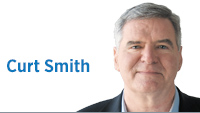Subscriber Benefit
As a subscriber you can listen to articles at work, in the car, or while you work out. Subscribe Now Better problems are in our future. That’s a good thing.
Better problems are in our future. That’s a good thing.
We have a full pipeline of economic development projects, which has led to a fight over a water pipeline. When you are fighting over water in Indiana, our future is bright, because we have plenty to share.
Just consider the depth and diversity of these projects. From electric-vehicle-battery manufacturing, to computer-chip assembly, to life-saving pharmaceuticals, to deep-well carbon capture, central Indiana is teeming with growth and opportunity.
These investments will give rise to new, better problems, whether related to water, workforce development, education, environmental concerns or beyond.
Let’s begin with the near-completion of Interstate 69 from Indianapolis to Evansville. This will be a boon to Indy’s south side—especially Morgan County, a beautiful area ripe for wise development. That will cause new problems between developers and environmentalists.
The catalyst for that project—the Major Moves transportation initiatives—also led to the upgrading of Keystone Avenue and Meridian Street into parkways on the north side, allowing more commuters ready access to the jobs and commerce. Westfield was recently recognized as one of America’s fastest-growing midsize cities. Noblesville, Fishers and Carmel are not far behind. These affluent cities are building sports arenas, polishing outdoor trails and parks, and landing great new employers almost daily.
Major Moves anticipated this growth, so Indiana built infrastructure that today attracts out-of-state workers. The day The Wall Street Journal published a lengthy article chronicling the success of Carmel in reducing commute times and increasing quality of life, this columnist was able to send it to a California couple closing on a new Carmel home. Combined, they had lived 25 years in Los Angeles.
Is it any wonder successful national leaders such as Vice President Mike Pence, former Gov. and Purdue University President Mitch Daniels, and retired Director of National Intelligence and U.S. Sen. Dan Coats all chose to settle on Indy’s north side following their public service?
They know the cost of living is low and the quality of life is high here in the Hoosier State’s capital city.
But perhaps the biggest catalyst of all is still emerging. The Lilly Endowment, thanks to the successes of Eli Lilly and Co., is now America’s largest private foundation, and its focus is largely—though not exclusively—on central Indiana. Its assets, of which 5% must be distributed annually, are hovering at about $80 billion.
So as the stock gains of late work into its calculus of giving, annual grants will ramp up to about $4 billion per year. Some analysts forecast Lilly will be the first trillion-dollar health care firm in market value, thereby boosting annual giving by the endowment to $5 billion. The 20-year-old Major Moves program, whose fruit is just now fully blossoming, cost roughly $4 billion in today’s dollars. The pipeline of opportunity is, indeed, full.
Such success requires us to better manage our ongoing problems, especially public safety and underperforming schools, but there is no doubt Indianapolis and environs are entering a prosperous era. Civic leaders will be challenged in a good way to make quality-of-life gains consistent with these economic advances. That is a better problem.
We need a new civic vision to guide us in the coming decades. From here, it is hard to improve upon Gerry Bepko’s suggestion several decades ago that we master “health, wellness, fitness and longevity.” Aging well is a better problem than the alternatives.•
__________
Smith is chairman of the Indiana Family Institute and author of “Deicide: Why Eliminating The Deity is Destroying America.” Send comments to ibjedit@ibj.com.
Click here for more Forefront columns.
Please enable JavaScript to view this content.
